In history there are people whose legacy becomes larger than life. Ask anyone who built and flew the first airplane, and you’d be hard-pressed to find someone who isn’t at least aware of the accomplishments of the Wright brothers. In a similar vein, Chuck Yeager’s pioneering trip into supersonic territory with the Bell X-1 airplane made his name essentially synonymous with the whole concept of flying faster than the speed of sound. This wasn’t the sole thing he did, of course: he also fought in WWII and Vietnam and worked as an instructor and test pilot, flying hundreds of different airplanes during his career.
Yeager’s insistence on making that first supersonic flight, despite having broken two ribs days earlier, became emblematic of the man himself: someone who never let challenges keep him from exploring the limits of the countless aircraft he flew, while inspiring others to give it their best shot. Perhaps ironically, it could be said that the only thing that ever held Yeager back was only having a high school diploma.
On December 7, 2020, Chuck Yeager died at the age of 97, leaving behind a legacy that will continue to inspire many for decades to come.
The Right Stuff

During the second World War, airplanes had undergone many changes to improve their performance, but the propeller-based airplanes of the time encountered practical limits even as they tried to fly ever faster and higher. While the advent of rocket and turbojet engines got around some of these limitations, one soon became aware of the dangers posed when approaching the speed of sound sound — the so-called transonic region.
The aerodynamics of this transition from subsonic to supersonic flight were poorly understood in the 1940s when the US began a joint research project on supersonic aircraft. The Bell X-1 was a research aircraft which was used to investigate this transonic region. Lacking solid data on what airplane shape would work best across sub- and supersonic speeds, a shape was picked which was known to be stable at supersonic speed: a Browning .50-caliber machine gun bullet.
Having solved this problem, all that was left was finding a test pilot who would want to fly this rocket-powered plane through the sound barrier. This term was coined during WW2 when fighter pilots would encounter the effects of compressibility: when nearing the speed of sound the aerodynamics acting upon the airplane would change dramatically, limiting them to around 800 km/h (even in a dive) above which they risked instability due to stalled control surfaces and other control issues which would result in a loss of the airplane.
Test pilots in the late 1940s were exposed to a lot of risk considering the countless airplane designs that had been dreamed up, built, and thrust into production in a matter of months during the war. But by all accounts this was a new frontier.
Join the Army, They Said
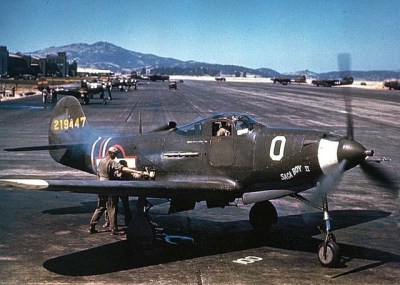
On February 13, 1923, a farming family in Myra, West Virginia welcomed their newest family member with the birth of Charles Elwood Yeager. By the time he was five, the family moved to Hamlin, West Virginia, where Yeager would attend Hamlin High School. His first experience with the military was during the summers of 1939 and 1940, when as a teenager he would attend the Citizens’ Military Training Camp at Fort Benjamin Harrison in Indiana, before he enlisted with the US Army Air Forces (USAAF) on September 12, 1941, where he became an aircraft mechanic stationed at the George Air Force Base in California.
When he enlisted, he was not eligible for flight training because of his age and educational background, but as the US entered the war a mere three months later, the recruiting standards by the USAAF were altered. On March 10, 1943 Yeager graduated from Class 43C and received his pilot wings. His first airplane was the Bell P-39 Airacobra, which his group trained on before they would ship overseas on November 23rd that year.
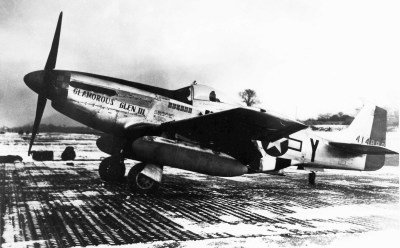
Stationed at RAF Leiston, Yeager would fly P-51 Mustangs, naming his P-51 Glamorous Glen, after his then girlfriend, Glennis Faye Dickhouse. Initially he flew seven missions without any issues, shooting down one enemy aircraft. Then, on his eighth mission his aircraft was shot down over France.
Fortunately, he was not captured by the enemy, but found himself escorted by the Maquis (French resistance) to Spain. While with the Maquis, he assisted them with tasks that did not involve directly fighting, such as the constructing of bombs, a skill which he had picked up from his father. On May 15, 1944 he was back in England.
Originally, Yeager and other “evaders” (pilots who had escaped from behind enemy lines) would not be allowed to fly over enemy terrain again, as they might be captured by the enemy and reveal secrets about the Resistance. Along with fellow P-51 pilot Fred Glover he went straight to the Supreme Allied Commander, General Dwight D. Eisenhower to protest this. Ultimately he was cleared for combat again, according to Yeager:
I raised so much hell that General Eisenhower finally let me go back to my squadron. He cleared me for combat after D Day, because all the free Frenchmen—Maquis and people like that—had surfaced.
Ultimately, Yeager would fly 61 missions during WW2, flying his last mission on January 15th of 1945, returning to the US the next month. With his now-wife Glennis pregnant with their first child, he chose an assignment at the Wright Field as this was close to their home. There he would be stationed under the command of Colonel Albert Boyd, head of the Aeronautical Systems Flight Test Division Here it was also that he would become a test pilot, qualifying due to his large number of flight hours and experience with aircraft maintenance.
Just Doing the Job
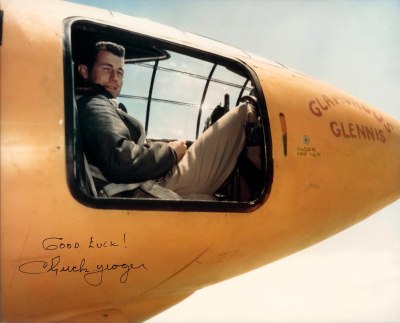
Bell Aircraft originally tapped test pilot Chalmers “Slick” Goodlin to fly the X-1 on its maiden test flight, but when he demanded $150,000 ($1.7 million in 2020) for the task, the USAAF instead picked Yeager as pilot. It was now 1947 and Yeager had graduated from Class 46C at the US Air Force Test Pilot School (412th Test Wing of the Air Force Materiel Command) at Wright-Patterson Air Force Base in Ohio to become a test pilot at Muroc Army Air Field (today: Edwards Air Force Base).
Two days before the scheduled test flight, Yeager fell from a horse, breaking two ribs. Despite the pain, he got a civilian doctor to tape him up so that he could still carry out the flight. Telling only his friend and fellow project pilot Jack Ridley about it. On the day of the flight, it was Ridley who helped improvise a mechanism which Yeager could use to seal the hatch of the X-1 “Glamorous Glennis” aircraft, as Yeager was in too much pain to do so the regular way.
The rest, as one says, is history. Although the successful flight wasn’t made public until a year later, his name in history had already been secured at that point. The flight itself was relatively uneventful. According to Yeager, the aircraft experienced a lot of turbulence as it went through the transonic phase, but once it went supersonic, it was very smooth. This flight would pave the way for many more supersonic flights, ultimately enabling the routine transitioning to supersonic travel of not only jet fighters but also commercial aircraft, while deepening our understanding of aerodynamics at trans- and supersonic speeds.
The Sky is the Limit
After his first supersonic flight, Yeager would go on to test more aircraft like the X-1 as well as many unlike it, such as the MiG-15 (from a North Korean defector) and the M2-F1 lifting body aircraft. When civilian National Advisory Committee for Aeronautics (NACA) pilot Scott Crossfield became the first pilot to travel at twice the speed of sound in 1953 with a D-558-2 Skyrocket, Ridley and Yeager managed to push the record to Mach 2.44 in the new X-1A, past the previous record and just in time before Crossfield’s achievement would be celebrated, in what they called Operation NACA Weep.
That particular X-1A flight almost went wrong, but Yeager managed to recover the aircraft in the nick of time. This was hardly the end of the excitement, however. During his deployment in Korea and the Vietnam War he would command several squadrons and wings. He also became the first commandant of the USAF Aerospace Research Pilot School, which also trained astronauts. Unfortunately, due to only having a high school diploma, he was not eligible for becoming an astronaut himself, leaving that door firmly closed.
A Broad Legacy
Chuck Yeager is quite literally a household name at this point. During the 1980s and 1990s a movie called The Right Stuff was released based on the 1979 book of the same title. This describes the test pilots involved in aeronautical research, including Yeager as well as those who would go on to be astronauts in Project Mercury, the first human spaceflight by the US. Yeager himself makes a cameo in this movie, as the barkeep in the bar where he in his own words “probably spent more time than in aircraft cockpits”.
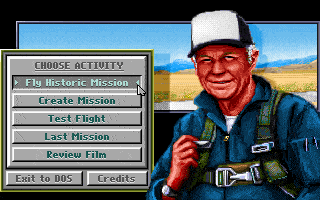
In 1987 Chuck Yeager’s Advanced Flight Trainer was released for home computers, which allows the player to take control of a number of airplanes, including the X-1, which features in-game comments by Yeager, such as when one crashes the plane. Yeager was a technical consultant on that game, as well as on Chuck Yeager’s Air Combat, which was released in 1991 and features missions Yeager has flown. Both Advanced Flight Trainer and Air Combat can now be found as abandonware.
Beyond public outreach, Yeager’s expertise was sought even after retirement in 1975, when after the 1986 Challenger disaster, Yeager was assigned by President Reagan to the Rogers Commission which was charged with investigating the disaster.
On October 14, 1997, Yeager flew a new Glamorous Glenn III (an F-15D Eagle) past Mach 1 to celebrate the 50th anniversary of that first time in the X-1, and again in 2012, as co-pilot in an F-15 at the age of 89. During the speech in 1997 he ended with the words: “All that I am… I owe to the Air Force.”, yet it is hard not to see him as an instrumental part of everything that was achieved in aeronautics.
More recently, I had the honor of following Chuck Yeager on Twitter, where (along with other legends like Buzz Aldrin), they are just interacting like normal people, despite their major achievements. I admired Yeager for his quick wit and down to earth commentary. He was eager to educate and teach people, and an all-around pleasant personality.
While his legacy will live on, Chuck Yeager as a person will be sorely missed.

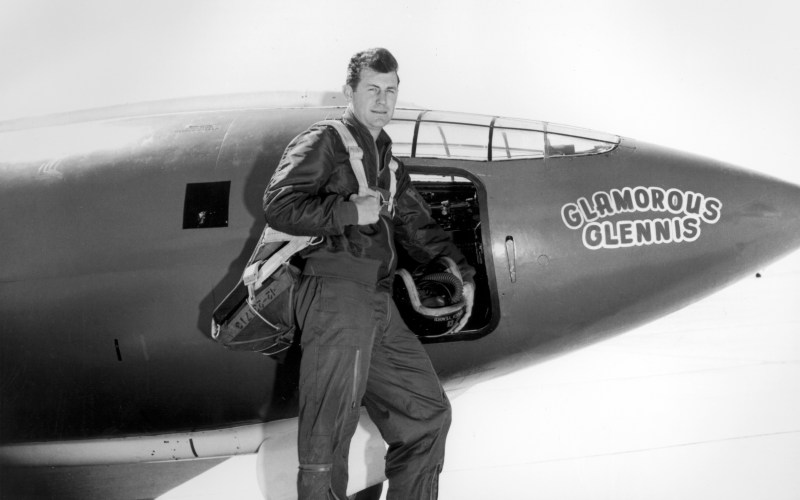














Not meaning to detract from his accomplishment but I’ve seen something about an RAF piot breaking the sound barrier in a steep diving Spitfire during WWII. Anybody elaborate on this?
Like this? https://www.bbc.com/future/article/20160505-the-spitfires-that-nearly-broke-the-sound-barrier
I’ve heard of P47s going through the sound barrier in a dive.
It is very unlikely a prop plane broke the sound barrier and stayed intact. There IS some evidence the sound barrier was broken by a conventional jet (XP-86 Sabre, piloted by George Welch) before the X1 made it’s supersonic flight and again on the same day. Both in a slight dive, which is why they added the “in level flight” moniker to effectively make sure the claim couldn’t be disputed.
Thats a myth, they don’t claim that they did that. 0.92 is the fastest claimed for the spitfire and even that damaged the engine and prop. If the aircraft ended up damaged, or was uncontrollable during flight it doesn’t make sense to call it a valid claim.
During WWII the only things going supersonic were missiles and bullets nothing manned as nobody had solved the problem of controllable flight above mach 1…
Yes, there are stories of aircraft going close to the sound barrier or even maybe braking it during WWII, but these were all in a dive and accidentally. What Yeager did was be the first person to intentionally break the sound barrier (go faster than Mach 1) on purpose in an aircraft built specifically to break the sound barrier.
compressibility……the x-1 was the first to fly straight and level…prop ac were not strong enough to withstand the compressibility issue at the time……i think lol..general yeager explains it well in his book.
As you say, he was not the first to successfully break the sound barrier. That was never the claim. He was the first to successfully break the sound barrier intentionally in straight, level flight.
The P38 could also do it easily in a dive but horizontally and keeping the plan in one piece is a different thing.
They also had a problem with compressability.
I do love “building bombs, a skill he picked up from his father”… boy those were different times.
Being from West Virginia coal mining used a lot of explosives probably a skill all of his friends in high school had.
I believe the point was he broke the sound barrier while in level or inclining flight, not in a dive.
“On the day of the flight, it was Ridley who helped improvise a mechanism which Yeager could use to seal the hatch of the X-1”
It’s a hack!
(IIRC, it was a section of broomstick with a hook attached.)
P.S. He didn’t get his ribs broke in a bar fight?
Nope, riding a horse with his wife.
That made me do a double take because when I first read it I missed the “a horse with” part! :o
Breaking your ribs whilst riding your wife would be… impressive.
As would getting into a bar fight with a horse.
Or maybe getting into a bar fight with a horse for riding his wife…
Could have been Chuck Yeager making the first steps on the moon, if not for the snobby elitism of only allowing men with some college degree to be astronauts. Never mind his skill and experience were exactly what a “steely eyed missile man” needed back then.
Not having a college degree was the “official” reason given for not getting into the astronaut program. In reality there were some other factors at play. Unofficially Yeager had a personality that just didn’t mesh with what the astronaut program needed, nor did he understand the intricacies involved with non aerodynamic flight. Reading the report from the NF-104 crash that Yeager always maintained was due to inherent faults in the aircraft and not his fault from the perspective of the lead test pilot leads me to conclude that Yeager was out of his element there: http://www.kalimera.org/nf104/stories/stories_12.html (Read the rest too, very interesting)
That is not to diminish what Chuck Yeager achieved over his long and impressive career, the man was a damn impressive pilot and in a class of his own when it comes to aerodynamic flight. But what the Mercury, Gemini and Apollo programs needed wasn’t pilots skilled in aerodynamic flight but men who could do more beyond just controlling the capsule, like providing input on designs, operate the complicated spacecraft systems, figure out orbital mechanics and navigation and work very closely with other people in close, cramped quarters for long periods of time. Chuck Yeager personality could at times be abrasive and “my way or the highway”.
I don’t think it’s fair to say it was “snobby elitism”, nor do I think he would have been a candidate for the first man on the moon. A crew with Yeager on board would have been closer to how Apollo 7 worked out I think.
But all of that is basically irrelevant. He wasn’t an active test pilot anymore (he was in command of a squadron of fighters iirc) when the Mercury program began and Yeager didn’t want to do it anyway. He didn’t see Mercury as “flying” and contended that the Mercury astronauts were basically just along for the ride anyway (Not entirely incorrect and he joked at some point he “didn’t want to have to wipe away the monkey shit before I sit down”). By the time Gemini came around he was basically getting too old (He was 41 by 1964).
Yeager reveled in being a pain in the rear. His folksy, aw-shucks-ism cultivated by his autobiography and The Right Stuff belied someone who held grudges and made a lot of enemies. Yeager’s ego cost him as much or more than his lack of college degree. Ironic, since he used his autobiography to trash pilots who he felt had giant ego’s such as George Welch (who claimed to have broken the sound barrier a couple weeks ahead of Yeager in an F-86 prototype)
His Twitter account was also likely run by his wife, who cut Yeager off from his kids and turned him into a cottage industry to live off of.
Hero? Great pilot? Sure. But his flaws were many and glossed over by the fighter jock mystique.
Ding! Ding! Ding! I knew him personally through family connections. He was an immensely unpleasant person to be around, and sucked all the air out of whatever room he was in. All of his stories were tinged with grievance, and he never learned how to live with the glory of his actual accomplishments.
Rather, he sought to diminish the accomplishments of others to salve his fragile ego. He was an amazing pilot and a terrible person.
Yeager didn’t like being told what to do, ever. And was personally responsible for getting the first Black astronaut candidate kicked out of the training program he was running for the 2nd class of incoming astronaut candidates. Look up Ed Dwight: https://en.wikipedia.org/wiki/Ed_Dwight. Word spread to other people in the group of candidates in Phase II to not be friendly or accepting towards Mr. Dwight. And eventually he was not accepted into the program.
From historical accounts of the actual folks present. Ed Dwight was graduated by Yeager, and his canidacy was passed onto NASA. However, he, and 271 other applicants – were not chosen. Why, will never be known (kind of like the wall of stars at CIA in Langley, or the pictures of SEAL operators who were KIA, on a wall in one of the Navy’s buildings in VA).. the actual facts are known only to a select few.
The Yeager comment to isolate Dwight is third-hand hearsay never corroborated by any first or second hand witness. Even Dwight made it clear it wasn’t Yeager who kept him out of the astronaut corps, but Dwight’s own attitudes and [most critically] the fact he was three inches too short to safely fly the Lunar Module.
The 104 altitude test flight mishap was due to the peroxide thrusters not firing to push the nose over so he would re-entered the atmosphere in the nose down position. Therefore the airplane was all but
unrecoverable most pilots if not perhaps all but Yeager would not have survived.
Sad to see him go. He was a childhood hero of mine.
I agree also. One of seven in my case. (Several of the astronauts. 3 Gemini, and 3 from Apollo.)
The book “Yeager” is a great read. I vaguely recall him recalling getting shot down during WW2, and then meeting up with some resistance fighters and sabotaging railways. Hell of a life.
Remember one of my crew as a youth was panicking about being razzed for initiation, so someone gave him Yeagers book. Later we find him in the alley taking a dump reading the book. After that our crew called taking a dump due to a stressful situation a “Yeager”
A worthy tribute of an article,
will miss Chuck Yeager, if you get the chance, read the mans book
for insite into these many stories; Flew the X-1 with a broken arm.
He certainly represented the best that America could do and Western civilization as well.
One word, Lipke. Lipke find out way before X-1, that arrow shaped wings get rid of dangerous vibrations during high speed flight with the same area for possitive pressure needed for safe flight. Straight wing of X-1 was already wrong obsolte design when it was built. Vibration were so severe that could easily disintegrated whole plane.
This is an important observation. In the US then and now you need(ed) both the money and free time to attend college, study, and keep yourself fed and housed. This cuts off the lower classes and those with parents who will not release their financials(up to age 24) from joining the officer corps as well as having opportunity in modern society. We have done away with most of the race and gender filter, but having the ability to take four years off from life is a privilege that is only available to the best students, those with parents who are willing to help, or someone from a country where upward mobility even for the poor is a respected value.
Part time ~200 level classes.
If K-12 is already covered by the welfare state why not make a universal opportunity for basic university even if it must be a subsidized loan but at a subsidized state school?
Few people “take four years off from life” by attending college, though I guess drinking is that popular at some schools.
Officers having to have a college degree is the actual political subject of the song “I am the very model of a modern major general” from the Pirates of Penzance; this idea that an officer should study history and algebra was very controversial at the time, but the military wanted to reduce the rate of atrocities. And requiring education helped. That’s why they did it.
Remember, it has only been a few hundred years since feeding the soldiers the day before battle was a rare and controversial practice believed to destroy morale, as they believed that the lower classes followed orders better if they were more downtrodden. During the English Civil War at one point they attempted to remove Cromwell from his command for the terrible military sin of paying his soldiers on time, even before battle. This was seen as a comically stupid thing to do, but for some reason (he fed them) they didn’t run away when they got their pay, but instead declared their loyalty!
The people who not only didn’t study history, but complain about the requirement, perhaps do not have the proper temperament for military leadership. And perhaps that sort of job is best done by those best suited for it. Perhaps being a military officer is not a birthright of all humans, but a terrible job that a few people will unfortunately be called on to do.
The X1 was derived from a British design. Churchill presented the design details to the USA the major difference being that a rocket was substituted for the original jet engine.
I remember a short conversation with him 20+years ago at Farnborough during which I asked him if he would have liked to got the world land speed record as well (Andy Green in the thrust ssc had shortly before broken the sound barrier). I got a barrage of fucking this and fucking that – “we were doing that fucking crap years ago at EAFB”. I got a real earful! I later related this explosive outburst to the cars owner Richard Noble, who then informed me that Yeager had not been the first, but had been the USAF choice over the companies test pilot. Noble’s take was that Yeager thought I was just winding him up.